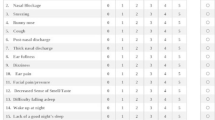Abstract
Objective
Blocking airflow into the sinonasal cavity after surgery may help to keep the cavity moist and thus decrease postoperative crusting. Here we investigated the efficacy of Rhino-Protect ointment following endoscopic sinus surgery (ESS).
Subjects and methods
A total of 93 patients with chronic rhinosinusitis who underwent identical ESS were enrolled. After surgery, all patients were instructed to perform nasal saline irrigation and deliver a nasal spray to each nostril, then to apply Rhino-Protect ointment to one nostril only; the other nostril served as a control. Subjective symptoms, postoperative Lund–Kennedy (LK) endoscopic scores, and adverse reactions 14 and 28 days after treatment were evaluated.
Results
The Rhino-Protect ointment significantly reduced pain (p = 0.015 at 28 days), dryness (p = 0.009 at 14 days and p = 0.045 at 28 days), and crusting (p = 0.047 at 14 days), and was associated with significantly lower LK scores 14 and 28 days after treatment (p = 0.037 and p = 0.007, respectively). Statistically significant differences were noted in the LK edema subscore at 14 days (p = 0.043) and in LK crusting subscores at 14 and 28 days (p = 0.005 and p = 0.006, respectively). No patient reported any serious adverse event associated with Rhino-Protect use.
Conclusion
Applying Rhino-Protect after ESS significantly reduced the formation of edema and crusts, leading to improving the patients’ discomfort for pain, dryness, and crust.



Similar content being viewed by others
References
Thaler ER (2009) Postoperative care after endoscopic sinus surgery. Arch Otolaryngol Head Neck Surg 128:1204–1206
Rudmik L, Soler ZM, Orlandi RR, Stewart MG, Bhattacharyya N, Kennedy DW et al (2011) Early postoperative are following endoscopic sinus surgery: an evidence-based review with recommendations. Int Forum Allergy Rhinol 1:417–430
Bugten V, Nordgard S, Steinsvag S (2006) The effects of debridement after endoscopic sinus surgery. Laryngoscope 116:2037–2043
Shi L, Feng Y, Cui W, Yan K, Lv M, Hong Z et al (2015) Effect evaluation of repeated debridement after endoscopic sinus surgery. Int J Clin Exp Med 8:928–933
Schwetz S, Olze H, Melchisedech S, Grigorov A, Latza R (2004) Efficacy of pollen blocker cream in the treatment of allergic rhinitis. Arch Otolaryngol Head Neck Surg 130:979–984
Geisthoff UW, Blum A, Rupp-Classen M, Plinkert PK (2005) Lipid-based nose ointment for allergic rhinitis. Otolaryngol Head Neck Surg 133:754–761
Li Y, Wang D, Liu Q, Liu J (2013) Randomized double-blind placebo-controlled crossover study of efficacy of pollen blocker cream for perennial allergic rhinitis. Am J Rhinol Allergy 27:299–303
Li Y, Cheng L, Chen X, Yang B, Wang D (2015) Efficacy evaluation of a pollen blocker cream against dust-mite allergy: a multicenter, randomized, double-blind, placebo-controlled crossover trial. Am J Rhinol Allergy 29:e129–e133
Miwa M, Nakajima N, Matsunaga M, Watanabe K (2006) Measurement of water loss in human nasal mucosa. Am J Rhinol 20:453–455
Kim SL, Kim SD, Na HS, Kim JW, Yi KI, Mun SJ, Cho KS (2019) The efficacy of cotton ball packing after endoscopic sinus surgery: a prospective, randomized, controlled trial. Auris Nasus Larynx 46:742–747
LanzaKennedy DCDW (1997) Adult rhinosinusitis defined. Otolaryngol Head Neck Surg 117:S1–S7
Lund VJ, Mackay IS (1993) Staging in rhinosinusitis. Rhinology 31:183–184
Lund VJ, Kennedy DW (1997) Staging for rhinosinusitis. Otolaryngol Head Neck Surg 117:S35–S40
Wei CC, Adappa ND, Cohen NA (2013) Use of topical nasal therapies in the management of chronic rhinosinusitis. Laryngoscope 123:2347–2359
Rabago D, Zgierska A, Mundt M, Barrett B, Bobula J, Maberry R (2002) Efficacy of daily hypertonic saline nasal irrigation among patients with sinusitis: a randomized controlled trial. J Fam Pract 51:1049–1055
Junker JP, Kamel RA, Caterson EJ, Eriksson E (2013) Clinical impact upon wound healing and inflammation in moist, wet, and dry environments. Adv Wound Care (New Rochelle) 2:348–356
Antisdel JL, Matijasec JL, Ting JY, Sindwani R (2011) Microporous polysaccharide hemospheres do not increase synechiae after sinus surgery: randomized controlled study. Am J Rhinol Allergy 25:268–271
Cho KS, Park CH, Hong SL, Kim MJ, Kim JY, Kim YW et al (2015) Comparative analysis of Cutanplast and Spongostan nasal packing after endoscopic sinus surgery: a prospective, randomized, multicenter study. Eur Arch Otorhinolaryngol 272:1699–1705
Brown AC, Slocum PC, Putthoff SL, Wallace WE, Foresman BH (1994) Exogenous lipoid pneumonia due to nasal application of petroleum jelly. Chest 105:968–969
Funding
This work was financially supported by Hanwha Pharma Co., Ltd. (Seoul, South Korea) and Dr. Theiss Naturwaren GmbH (Homburg, Germany).
Author information
Authors and Affiliations
Corresponding author
Ethics declarations
Conflict of interest
The authors declare that they have no competing interests.
Additional information
Publisher's Note
Springer Nature remains neutral with regard to jurisdictional claims in published maps and institutional affiliations.
Electronic supplementary material
Below is the link to the electronic supplementary material.
Rights and permissions
About this article
Cite this article
Cho, KS., Kim, S.W., Kim, J.K. et al. Efficacy of Rhino-Protect ointment after endoscopic sinus surgery: a prospective, randomized, multicenter study. Eur Arch Otorhinolaryngol 278, 109–115 (2021). https://doi.org/10.1007/s00405-020-06265-4
Received:
Accepted:
Published:
Issue Date:
DOI: https://doi.org/10.1007/s00405-020-06265-4




